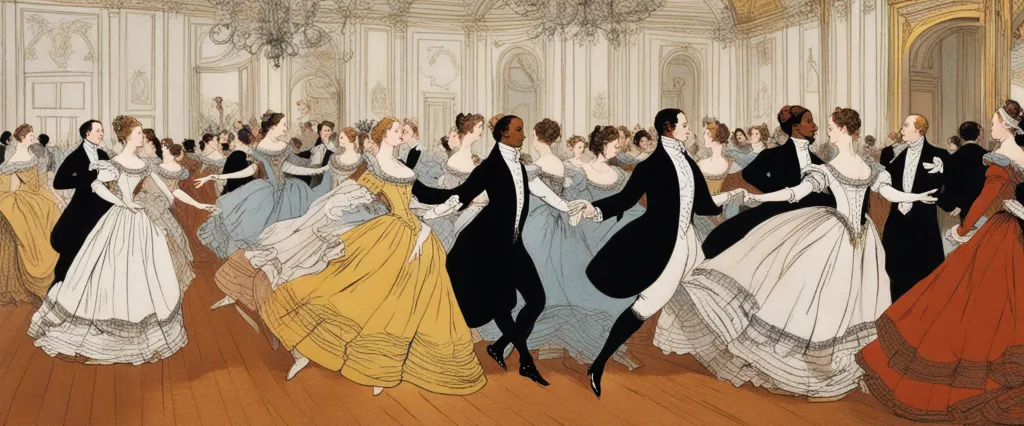
In the vast realm of historical literature, two remarkable books have emerged as indispensable sources of knowledge and understanding, shedding light on the intricate tapestries of civilizations and their enduring legacies. Orlando Figes’ “Natasha’s Dance” and David Hackett Fischer’s “Albion’s Seed” are captivating works that delve deep into the social, cultural, and historical fabrics of their respective subjects. Although these books explore different time periods and geographic regions, they share a common purpose: to unravel the intricate threads connecting the past with the present and to offer profound insights into the shaping of societies.
“Natasha’s Dance” transports readers on an illuminating journey through the rich cultural heritage of Russia, unravelling its tumultuous history through the lens of its art and literature. Figes skillfully weaves together stories of legendary artists, writers, and musicians, showcasing how their creations mirrored the ever-changing social and political landscape of the nation. From the opulence of the tsarist courts to the turbulent periods of revolution and the profound impact of Soviet rule, Figes unravels the complexities of Russian identity, encapsulated through the metaphorical dance of Natasha.
On the other hand, “Albion’s Seed” delves into the formation of the American nation, tracing the early migrations of four distinct groups of British origin: the Puritans, the Cavaliers, the Quakers, and the Scots-Irish. David Hackett Fischer masterfully blends historical accounts, language, folkways, and cultural traditions, highlighting how these groups left an indelible imprint on various regions of early America. By examining their distinct values, religious beliefs, and societal norms, Fischer uncovers the lasting legacies that continue to shape the United States to this day.
While both books explore distinct periods and cultures, they share a common thread: the impact of history on the collective consciousness of societies. Figes and Fischer draw readers into the depths of the past, demonstrating that history is not merely a remnant of bygone eras, but a living entity that continues to influence and shape the present. By meticulously examining the customs, traditions, and cultural phenomena prevalent in their respective societies, these authors shed light on the profound influences that history has on how we perceive and navigate the world around us.
In this comparative study, we will delve into the depths of Figes’ “Natasha’s Dance” and Fischer’s “Albion’s Seed,” analyzing their distinctive approaches, methodologies, and the insights they offer into the enduring legacies of Russia and America. Through a critical analysis of these two remarkable works, we aim to unravel the interconnectedness of history, culture, and collective memory, showcasing the power of these narratives in shaping the identities of nations and individuals alike. So, join us on this intellectual journey as we explore the intricate dance of history and its lasting impact on two remarkable civilizations.
Brief Summary of Two Books
Natasha’s Dance by Orlando Figes
Natasha’s Dance: A Cultural History of Russia” by Orlando Figes is a comprehensive exploration of the cultural and artistic history of Russia from the 17th century to the present day. Figes delves into the rich tapestry of Russian culture, examining how it evolved and influenced the country’s social, political, and economic developments.
The book takes its name from Leo Tolstoy’s character Natasha Rostova in “War and Peace,” symbolizing the purity and spirit of Russian identity. Figes begins by examining Russia’s unique geographical location and its role as a bridge between East and West, which contributed to the formation of its complex cultural identity.
The narrative spans various artistic forms, such as literature, music, visual arts, theater, and dance. Figes explores the works and lives of famous Russian figures like Tolstoy, Dostoevsky, Tchaikovsky, Stravinsky, and Diaghilev, along with countless less-known artists whose creations shaped Russian culture.
Natasha’s Dance uncovers how literature, particularly the works of Pushkin, Gogol, and Dostoevsky, played a significant role in defining the Russian character, grappling with themes of national identity, spirituality, and social transformation.
Figes also delves into the development of Russian music, from the traditional chants of the Orthodox Church to the compositions of the mighty Five, highlighting the influence of Russian folk songs and the fusion of Western and Russian musical styles.
The book further explores the history and significance of Russian visual arts, examining the works of renowned painters like Repin and Serov, and the birth of the avant-garde movement in the early 20th century with figures such as Malevich and Kandinsky.
The influence of theater and ballet receives special attention, with the likes of Stanislavsky and Meyerhold shaping the theater scene, while ballet companies, most notably the Ballets Russes, gained international acclaim with visionary choreographers such as Pavlova and Nijinsky.
Throughout the book, Figes intertwines the artistic journey with Russia’s political and social transformations, shedding light on how cultural movements reflected and sometimes challenged prevailing ideologies, leading to both reformation and repression.
In “Natasha’s Dance,” Orlando Figes offers readers a vivid and compelling account of Russia’s cultural heritage, illuminating its relationship with history, politics, and society. The book captures the essence of Russian culture and its enduring impact on the world stage.
Albion’s Seed by David Hackett Fischer
“Albion’s Seed” written by David Hackett Fischer is a comprehensive account of the four English migrations to America that took place during the 17th and 18th centuries. The book explores the cultural, religious, and social foundations of these early settlers and their subsequent influence on American society.
Fischer focuses on four distinct groups of settlers: the Puritans from East Anglia, the Cavaliers from the English West Country, the Quakers from the North Midlands, and the Scotch-Irish from the border region between England and Scotland. He examines their reasons for migrating, their religious beliefs, their customs and traditions, and how they established their distinct regional identities in America.
Through extensive research and analysis of primary sources, including diaries, letters, church records, and legal documents, Fischer delves into various aspects of these settlers’ lives, including their family structures, gender roles, economic pursuits, and political ideologies. He demonstrates how their distinctive cultural practices and values continued to shape American society long after their arrival, influencing everything from education and law to religion and politics.
The book also explores the conflicts and interactions among these different groups, shedding light on the prevailing tensions and dynamics within colonial America. Fischer shows how these clashes over land, religion, and political power helped define not only the early colonial period but also the subsequent development of the United States.
Overall, “Albion’s Seed” provides a rich and insightful examination of the early English migrations to America and the lasting impact these settlers had on American culture and society. It highlights the diverse origins, values, and behaviors of the English colonizers and offers a deeper understanding of the complex historical roots that continue to shape the United States today.
Comparison between Two Books

Similarities in cultural history
Both Natasha’s Dance by Orlando Figes and Albion’s Seed by David Hackett Fischer explore the cultural history of different societies, albeit focusing on different regions and time periods. Despite the differences in their scope, these books reveal several similarities in their approach to cultural history.
Firstly, both books emphasize the importance of understanding the historical context and its influence on shaping culture. Natasha’s Dance delves into Russian history, particularly the impact of events such as the Mongol invasion, Peter the Great’s reforms, and the Bolshevik revolution on Russian artistic expression. Similarly, Albion’s Seed examines four distinct British regional cultures that settled in America, highlighting the influence of historical events like the English Civil War, Reformation, and Enlightenment on the settlers’ customs and traditions.
Secondly, both authors employ extensive research to support their arguments and provide a nuanced understanding of culture. Figes and Fischer draw on a wide range of sources, including diaries, letters, literature, and visual art, to reconstruct the cultural milieu of their respective regions. This meticulous approach adds depth and credibility to their narratives and enables readers to grasp the complexity of these cultures.
Thirdly, both books recognize the significance of cultural continuity and the ways in which traditions and practices endure over time. Natasha’s Dance explores how Russian culture and values persisted despite attempts at forced Westernization during certain periods. Similarly, Albion’s Seed explores how the British regional cultures that immigrated to America retained distinct social patterns, religious beliefs, and folkways for generations.
Lastly, both texts convey the idea that culture is not monolithic but rather a dynamic interplay of various influences. Natasha’s Dance discusses the synthesis of Russian, European, and Oriental elements in Russian culture, highlighting the constant interaction and exchange between different cultures. Albion’s Seed similarly illustrates how the regional cultures it examines are shaped by a combination of British, American Indian, and African influences, resulting in unique and evolving cultural expressions.
In conclusion, while Natasha’s Dance and Albion’s Seed focus on different regions and time periods, they share several similarities in their approach to cultural history. Both books emphasize the importance of historical context, employ extensive research, recognize cultural continuity, and highlight the dynamic nature of culture. Together, they offer valuable insights into the ways in which historical events, traditions, and interactions shape the cultural identities of societies.
Divergences in cultural history
Natasha’s Dance by Orlando Figes and Albion’s Seed by David Hackett Fischer are both significant works in the field of cultural history, focusing on different aspects of historical and cultural development. Despite their shared interest in exploring the roots of cultural identity, these books diverge in their approaches, subjects, and geographic focus.
Natasha’s Dance delves into the cultural history of Russia, examining the evolution of Russian culture from the early days of Tsarist Russia to the revolutions of the early 20th century. Figes explores various facets such as literature, music, visual arts, and social customs to provide a comprehensive account of how Russian culture developed, shaped, and reflected the country’s identity. The book offers a deep analysis of how political, social, and religious factors influenced Russian culture throughout history.
On the other hand, Albion’s Seed focuses on the cultural history of four distinct British regional cultures and their impact on the shaping of American society. Fischer explores the cultural migration from England to America in the 17th and 18th centuries, with each regional culture (Puritans, Cavaliers, Quakers, and Borderers) establishing distinct traditions, values, and ways of life in the colonies. Fischer highlights how these cultural legacies continued to shape American society, politics, and religion long after the initial settlement period.
One of the key divergences between the two books is their geographic focus. While both books analyze the cultural history of a specific region, Natasha’s Dance solely focuses on Russia, while Albion’s Seed expands its scope to examine the British cultural heritage in America. This divergence allows Fischer to explore the connections between British regional cultures and the subsequent development of American society, while Figes maintains a singular focus on the Russian context.
Another divergence lies in the time periods covered. Natasha’s Dance covers a broader range of history, beginning with Peter the Great’s reforms in the early 18th century and concluding with the cultural upheaval of the early 20th century. In contrast, Albion’s Seed concentrates on the cultural migration to America, primarily focusing on the 17th and 18th centuries. This difference in temporal scope allows for a more in-depth analysis of the transformation and continuity of cultural practices over an extended period in Natasha’s Dance, whereas Albion’s Seed primarily explores the initial transplantation of British cultural traditions to America.
Furthermore, the books differ in their methodological approaches. While both authors extensively research primary and secondary sources, Figes adopts a more narrative and descriptive approach, complemented by colorful anecdotes and individual stories. He emphasizes the importance of cultural expressions and aesthetics within the Russian context. In contrast, Fischer’s approach in Albion’s Seed is more analytical and comparative, drawing upon quantitative data and sociological frameworks to highlight the enduring impact of British regional cultures on American society.
In summary, while both Natasha’s Dance by Orlando Figes and Albion’s Seed by David Hackett Fischer explore cultural history, they differ in terms of geographic focus, time periods covered, and methodological approaches. Despite these divergences, both books offer valuable insights into the role of culture and heritage in shaping identity and society.

Conclusion
Both “Natasha’s Dance” by Orlando Figes and “Albion’s Seed” by David Hackett Fischer are highly regarded works in their respective fields.
“Natasha’s Dance: A Cultural History of Russia” by Orlando Figes examines Russia’s rich cultural history, exploring its art, literature, and music throughout the centuries. It covers a wide range of topics, from the impact of foreign influences to the tension between Westernization and Slavophile traditions. It has received praise for its vivid storytelling and insightful analysis, offering a comprehensive view of Russian culture.
“Albion’s Seed: Four British Folkways in America” by David Hackett Fischer is a seminal work in American history that explores the impact of four distinct British cultural groups (the Puritans, Cavaliers, Quakers, and Borderers) in shaping different regions of America. It delves into the various social, political, religious, and economic factors that influenced the formation of American culture. “Albion’s Seed” is lauded for its meticulous research, depth of analysis, and its ability to challenge traditional historical interpretations.
Deciding which book is more worthy of reading depends on your interests and preferences. If you have a keen interest in Russian cultural history, “Natasha’s Dance” may be more appealing. If you are intrigued by the different cultural influences that shaped early America, “Albion’s Seed” is likely to be of great interest. Both books have received positive reviews and are considered contributions to their respective fields.


